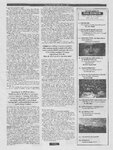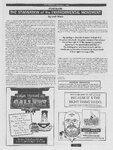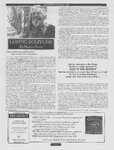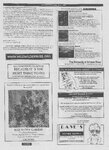| OCR Text |
Show THE ZEPHYR/ APRIL-MAY 2006 THE LAKE POWELL to ST. GEORGE PIPELINE...8 GLOBAL WARMING The latest Glen Canyon Institute ADVENTURE By Dr. Richard Ingebretsen The thirst for water and runaway growth can never be quenched for developers. The latest plan to allow massive growth where it makes no sense at all is in Utah’s Dixie—St. George. The plan is to build a water line from Lake Powell to St. George, a city built smack dab in the middle of the desert. It will deliver around 70,000 acre feet of water annually to this growing area that developers hope will allow a city of 65,000 people to grow to nearly 500,000 people over the next 30 years. The pipeline is to be subsidized primarily by raising the Utah Sales tax for all Utah residents. Developers are|hopeful that the taxes will be raised soon, even though the project will likely not start for 15 years. The idea is to spread the raise over a long period of time so that the impact to tax payers will not be as severe and will go unnoticed by taxpayers. The need for water from Lake Powell is based on a report prepared in 1998 by Boyle Engineering, now referred to as the Boyle Report. It made a number of population growth and water needs projections for St. George and Washington County, Utah. To the glee of developers, the report predicted that St. George could reach a population close to 500,000 by 2045. It concluded that the region would eventually run out of water using current sources. Therefore it was recommended that a Lake Powell to St. George pipeline be built as "the best solution to future water shortages.” The report did not take into account the current or ture effects of global warming. predicted to outweigh the costs of construction. The WCWCD still predicts the project will ‘be complete by 2030. But, is the pipeline really needed? Do we really have to raise statewide sales taxes? Do we really need to take water from a river, where there really is no more water to be taken? Do we need to hurt the fragile ecosystem of the Colorado Plateau? Do the residents of St. _George really want to see that city get that big so fast? Is growth in a desert a really good thing when conservation isn’t the main priority? To answer these questions, let’s first look at the city. St. George Utah is the most rapidly ‘growing city in the state of Utah, growing 73% from 1990 to 2000. And that is nothing compared to what some experts predict for the future. The problem is that it just happens to be located in the driest county in the second driest state in the country. More remarkably, St. George already has the highest per capita water consumption rate for desert cities in the U.S. and quite possibly the entire nation. Residents use a staggering 335 gallons per person per day. For comparison, Phoenix uses only 170 gallons per person per day, half that of St; George. This is because city ordinances designed to conserve water have proved invaluable in reducing water use. Similar ordinances in other cities such as Las Vegas, Tucson, and Los Angeles have proved invaluable as well. But neither St. George nor Washington County have ordinances in place for water conservation or landscaping, and apparently that does Welcome to ST GEORGE, UTAH Once in awhile, you find a place with charm, beauty, spirit & excitement... A place with a colorful past and a vision for the future. From the St. George Chamber of Commerce web site. Dr. Richard Ingebretsen, president of the Glen C: anyon Institute examines a Lake Powell channel marker in 2005, left high and dr y by the drought. Water for the pipeline would come out of Utah’s allocation of Colorado River water. The water for the pipeline would be stored in Flaming Gorge Reservoir where 70,000 acre feet annually would be released down the Green River into Lake Powell. The pipeline would pump this water from Lake Powell, 7 miles north of Glen Canyon Dam, over 120 miles of land into the Sand Hollow Reservoir located 10 miles east of St. George. The pipeline is currently planned to follow Highways 89 and 59 as much as possible through Utah, avoiding wilderness areas, but crossing through a Native American reservation. However, the pipeline will largely fall under current highway right of ways. Only 60,000 acre-feet would make it to St. George, the other 10,000 would go to the city of Kanab and other future developments along the 130 miles of pipeline. From Lake Powell the water would be pumped uphill for a small portion of the journey; gravity would then pull the water into St. George where it would fill a reservoir and power a hydroelectric plant. Sales of the electricity created would pay for part of the pumping dosts. Kanab would have to pick up a share of the price. But the costs of the water project are staggering. Engineering studies commissioned by CWCD), the Utah Division of Water Resources (DWR) show that the pipeline construction costs would be around half a billion the Washington County Water Conservancy District (W dollars---too high to begin construction now. Raising revenues will take some time. But more revealing are recent studies that indicat 2 Lake Powell is going to be much lower, even empty, than it has been in the past. There is a strong possibility that Lake Powell will empty and then remain very low. Assuming that Upper Basin consumptive use remains at the current 4.1 million acre feet, Lake Powell will be less than 50% full of its total storage capacity more than half of the time. But consumptive use is expected to increase to 5.4 mill ion acre feet per year which would keep the level of Lake Powell to 25% or less one half of the time. But that is not the bad news for the river — global w arming is. The Colorado River and its water resources are part icularly susceptible to the effects of climate change due to the current warming of the earth ‘s atmosphere. The effects of global warming are almost too incomprehensible to believe. E ut we are seeing them already. The premise is that as the earth’s temperature rises, water f rom the oceans evaporate, and then _ the water itself becomes a greenhouse gas, causing an al arming increase in the rate at which the temperature rises. With more moisture in the atmo; sphere and increased temperatures, there will be more rain in the valleys and a marked decrease in the snowpack in the mountains. The Colorado River Basin relies on snov wpack for 75% of its water source. While global warming models disagree on the exact am« punt, all models agree that there will be at least a 25 — 30% reduction of water in the Green a1 nd Colorado River by the year 2039. This is a huge loss for a river that is already in deficit t 0 demand. So with the increased demand on water, and with he enormous decrease in available water due to the continued effects of global warming there will not be enough water to fill the rivers, or fill Lake Powell, and much less fill a pipeline traveling to St. George If you don’t believe this, drive down and look over the edge of Lake Powell. It is less than 4 empty right now due to global warming. But, the WCWCD and the DWR don’t seem to care and are not giving up. They are currently trying to lobby Congress and the Utah Legislature to appropriate funds for the. project. As water in the region becomes even scarcer, the benefits of piping water in are not bother the Washington County Water Conservancy District, for they are pressing on developing the pipeline without one word of conservation. Several years ago, the Grand Canyon Trust, a Flagstaff based environmental organization commissioned a study by Hydrosphere Resource Consultants to explore solutions to the inevitable growth of St. George and surrounding areas. The study concluded that Washington County can accommodate projected water use needs for the next 50 years using water conservation measures, and that the proposed pipeline from Lake Powell to St. George is not needed. The Hydrosphere Study questioned the two basic assumptions of the Boyle Report. They made a more conservative population estimate of 340,000 by 2050. The report claimed that Boyle had overestimated population growth based on consolidated development plans in 12 municipalities in Washington County. Population projections of the Boyle Report were based on 1988 data prepared by the Utah Governor's Office of Planning and Budget, and did not account for factors such as the availability of developable land, land use, and zoning. Per capita water use in the Boyle Report was also somewhat miscalculated according to Hydrosphere, as all classes of water use were included in the estimate with the underlying assumption that all sectors, ial, industrial and residential, would grow in direct proportion to population growth. The Hydrosphere Study found the Boyle Report used outdated and flawed data, therefore future water demand figures were overestimations as well. St. George already has the highest per capita water consumption rate for desert cities in the Southwest...Residents use a staggering 335 gallons per person per day...Phoenix uses 170 gallons a day. Half that of St George. Hydrosphere concludes that water use rates will be significantly lower than those reported by the Boyle Report and that in order to satisfy realistic water needs of the region in the future, no imported water will be required. In addition, the study suggests environmental concerns must be addressed, particularly the potential impact of exotic fish species on native species in the Upper Virgin River basin which are listed as threatened and endangered. In fact, the Study shows that "based on the Governor's Office of Planning and Budget 1999 population growth scenarios in Washington County, few additional water supply projects would be needed to meet future water needs." The Hydrosphere study also found that Boyle had grossly overestimated future water use. Hydrosphere used an economic / financial model for determining future water use. The model took into account economic factors like price elasticity, as new water supplies are tapped prices go up and people conserve more and per capita water use goes down. The Boyle Report didn’t take these factors into account. Based on the new population growth and water use estimates, the Hydrosphere Report concluded that no new water sources peu |


































